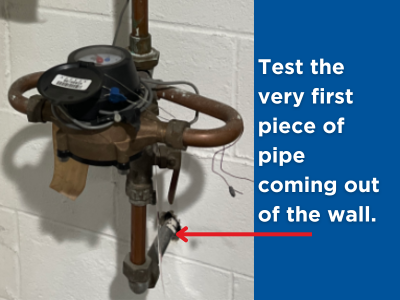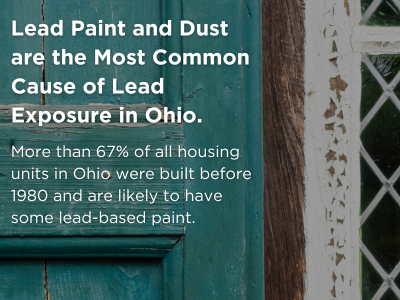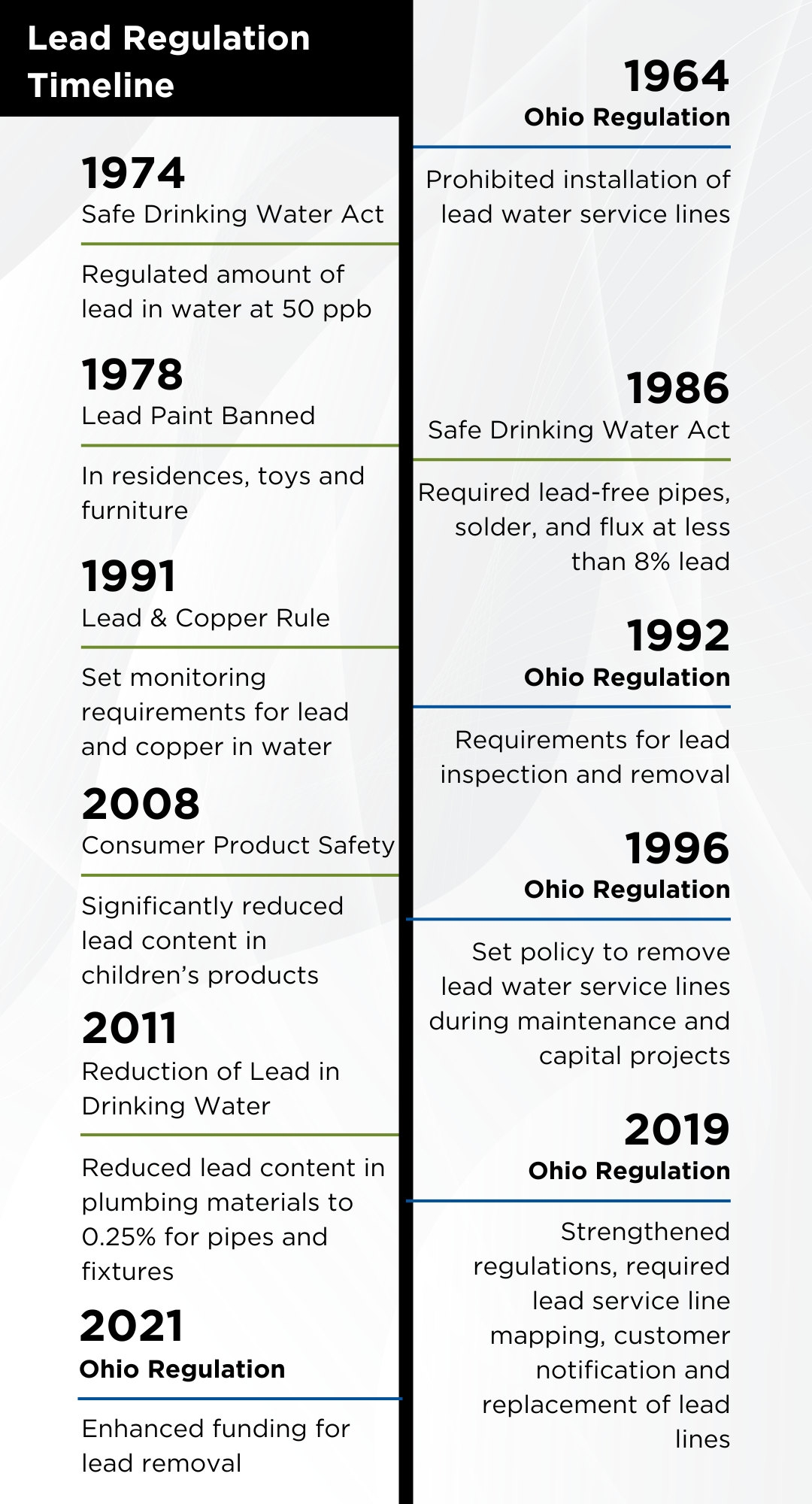There is no detectable lead in the treated water leaving Columbus water plants, or in the source water these plants use.
Lead can enter drinking water through the corrosion of lead or lead-contaminated water service lines, fixtures (such as faucets), or plumbing.
Columbus has a very effective corrosion control treatment process that protects pipes from corrosion. The water chemistry (pH) is adjusted and zinc orthophosphate is added. This process creates a coating in the pipes to serve as a barrier, preventing conditions that can cause lead to leach into the water. The most recent sample results were less than 1.3 parts per billion of lead in water.
With our effective treatment, we can confidently say the primary cause of elevated lead blood levels in Columbus is lead paint and dust.
What is Columbus doing about lead water service lines?
Columbus has been removing lead water service lines in capital improvement projects and maintenance work since 1996. Starting in 2025, the city will begin planning the Lead Service Line Replacement Program to remove lead and lead-contaminated water service lines. Visit the Lead Service Line Replacement Program page to learn more.
Columbus is creating an inventory of all water service line materials. This inventory will help the city decide where to target lead removal efforts. View the inventory here.
View our Potential Sources of Lead Guide(PDF, 363KB)
View our most recent water quality report.(PDF, 3MB)
Pipe Up! What is your water service line material?

Follow three easy steps to identify your water service line by using a flathead screwdriver, refrigerator magnet and a penny.
Instructions to identify your service line material.(PDF, 1MB)
For assistance verifying your service line material, contact Lead-Safe Columbus
Your participation helps Columbus build our service line material inventory and plan the lead water service line replacement program.
Tell us your service line material
Is there lead in Columbus' water? There is no detectable lead in the treated water leaving Columbus water plants, nor in the source water these plants use. Columbus has a very effective corrosion control program that reduces the potential for lead pipes to contaminate drinking water.
During the last testing period more than 90% of homes tested had less than 1.3 parts per billion, well below the federal action level of 15 parts per billion.

Common sources of lead exposure include:
- Lead paint (banned since 1978) and dust, especially lead painted window and door frames
- Lead pots and pans
- Lead and copper plumbing materials, including lead solder, and brass fixtures prior to 2014
- Lead contaminated dust or soil
- Certain types of pottery, pewter, jewelry and cosmetics
If your home was built after 1965, you do not have lead water service lines. In 1964 Columbus' Department of Public Utilities disallowed the installation of lead service lines.
How can lead affect my health?
Exposure to lead can be harmful. A build-up of lead in the body can cause damage to the brain or kidneys, or interfere with the production of red blood cells that carry oxygen to all parts of the body. The greatest risk is to infants, young children and pregnant women.
Some water service lines, home plumbing (pipes, fittings, solder) and plumbing fixtures, such as faucets, contain lead. As water sits in household plumbing over long periods of time, such as overnight or during work and school hours, lead can leach into water.
Water line breaks and repairs in areas with lead service lines may cause disruptions in water quality, including discolored water and/or potentially a temporary increase in lead levels in drinking water.
 Know your plumbing materials
Know your plumbing materials
- Homes built before 1964 may still have a lead service line
- Homes built before 1989 may have copper pipe with lead solder
- Plumbing fixtures (like faucets) made prior to 2014 may contain up to 8% lead
How to identify your water service line material(PDF, 1MB)
The Division of Water (DOW) is committed to providing equal access to high-quality water. Water tests are performed daily. We use a complex multi-barrier treatment process to assure safe drinking water is delivered to our customers. 
Last year, our Water Quality Assurance Lab completed over 70,000 water quality tests. View our most recent water quality report(PDF, 2MB) which shows the types and amounts of key elements in your drinking water and the water treatment process.
How does the Division of Water protect us from lead exposure?
Lead enters drinking water when it has been sitting in lead or lead-contaminated pipes for several hours. Columbus has a very effective program that protects pipes from corrosion. Columbus adjusts the water's chemistry (pH) and adds zinc orthophosphate. This process makes the water less corrosive and creates a coating in the pipes to serve as a barrier. This prevents conditions that can cause lead to leach into water.
Columbus has maintained an exceptionally low lead level of less than 2 parts per billion for over two decades.
Current lead policies:
- Columbus Division of Water has removed lead lines it encounters in capital improvement projects and emergency repairs since 1996.
- The repair of lead and galvanized water service lines is prohibited. These water lines must be fully replaced with non-lead materials.
Learn More About Common Water Quality Concerns here.

Run your tap when water hasn’t been used for 6 or more hours and after any work on your plumbing or disruptions in water service. Run water until you feel a temperature change, then run for 1 more minute. Flushing is very effective at reducing lead contaminated water coming from the tap.
Small screen disks- known as aerators- play a big role in your home’s water quality. Regularly cleaning aerators is highly recommended to keep quality water coming from the tap.
Always use cold water for drinking, cooking and preparing baby formula. Cold water is less corrosive on pipes.
Did you know? Fixtures, such as faucets, made before 2014 may contain up to 8% lead. Consider replacing these to remove additional sources of lead from your home.
For more information, see Reducing Exposure to Lead in Water(PDF, 406KB) or email leadsafelines@columbus.gov.
 View a larger version of potential sources of lead in water graphic.(JPG, 300KB)
View a larger version of potential sources of lead in water graphic.(JPG, 300KB)

The City of Columbus has set the goal for all Columbus children to be lead free by 2040.
Columbus Public Health, Department of Public Utilities and Department of Development are working together to reduce lead exposure in Columbus.
Do you have lead paint or fixtures in or outside your home? You may be eligible to receive assistance to remove lead from your home through one of the following programs.
Policies
- Columbus Division of Water has removed lead lines it encounters in capital improvement projects and emergency repairs since 1996
- The repair of lead and galvanized water service lines is prohibited. These water lines must be fully replaced with non-lead or lead-contaminated materials; replaced with material other than lead or galvanized.
Programs
- Columbus Public Health, Healthy Children and Safe Homes by 2040: This project is a bold, collaborative intervention to prevent all children in Columbus from being lead poisoned by the year 2040. Healthy Homes Project helps residents stop exposure to lead, including education, consultation services, free HEPA vacuum loan, and referral services. To learn more, call the Healthy Homes Hotline at 614-724-6000
